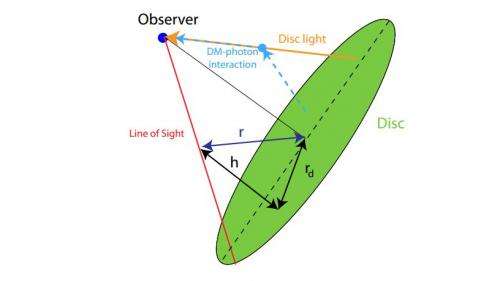February 11, 2015 report
Research pair suggests dark matter could create halos of light around galaxies

(Phys.org)—A pair of researchers affiliated with Institut d'Astrophysique de Paris has suggested that dark matter may impact light in a way not thought of before. In their paper published in the journal Physical Review Letters, Jonathan Davis and Joseph Silk suggest that dark matter could scatter light from stars creating halos of light around galaxies.
Scientists believe that roughly 80 percent of the total amount of matter in the universe is dark matter—this despite the fact that no one has been able to prove that it actually exists. Evidence for it is secondary—it must be there, the thinking goes, because something has to be keeping galaxies from flinging themselves apart as they spin. The problem with dark matter is that it does not reflect or react with light, making it impossible for us to see it, if it is there—at least that is the conventional view. But, Davis and Silk believe it is possible that there is an exception. In their paper they suggest it might be dark matter that is responsible for the creation of halos of light at the outer edges of galaxies.
The two start with the question of just how dark is dark, when theorizing about dark matter. Just because light appears to pass straight through it, they ask, does that mean the mysterious material is perfectly dark? They wonder if it is possible that starlight may be scattered by dark matter, if so, they suggest, it might create a halo effect, similar to a lamp held aloft in fog.
They offer as an example, the Pinwheel galaxy M101, which has been well studied. It has a glow around its edges but no one has been able to prove what causes that glow to come about. It could be due to dark matter, they suggest, while acknowledging that it could just as easily be due to other sources. They note that starlight at the edges of galaxies should be at their dimmest, instead there is a glow, which we are able to see because of the limited amount of light coming directly from the stars. They believe that it should be possible to prove if the glow is due to interactions with dark matter, by studying the wavelengths of light emanating from the glow and comparing it with other sources.
More information: Glow in the Dark Matter: Observing Galactic Halos with Scattered Light, Jonathan H. Davis and Joseph Silk, Phys. Rev. Lett. 114, 051303 – Published 4 February 2015. dx.doi.org/10.1103/PhysRevLett.114.051303 . On Arxiv: arxiv.org/abs/1410.5423
ABSTRACT
We consider the observation of diffuse halos of light around the discs of spiral galaxies, as a probe of the interaction cross section between dark matter (DM) and photons. Using the galaxy M101 as an example, we show that for a scattering cross section at the level of 10−23(m/GeV) cm2 or greater dark matter in the halo will scatter light out from the more luminous center of the disc to larger radii, contributing to an effective increased surface brightness at the edges of the observed area on the sky. This allows us to set an upper limit on the DM-photon cross section using data from the Dragonfly instrument. We then show how to improve this constraint, and the potential for discovery, by combining the radial profile of DM-photon scattering with measurements at multiple wavelengths. Observation of diffuse light presents a new and potentially powerful way to probe the interactions of dark matter with photons, a way that is complementary to existing searches.
Journal information: Physical Review Letters , arXiv
© 2015 Phys.org


















